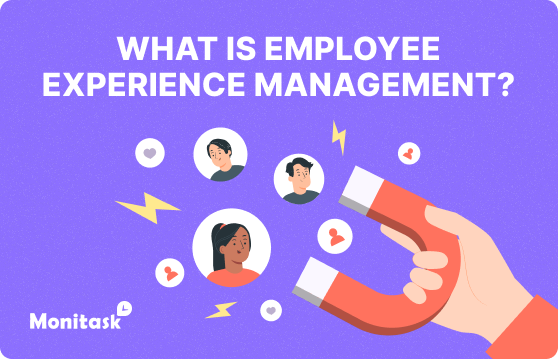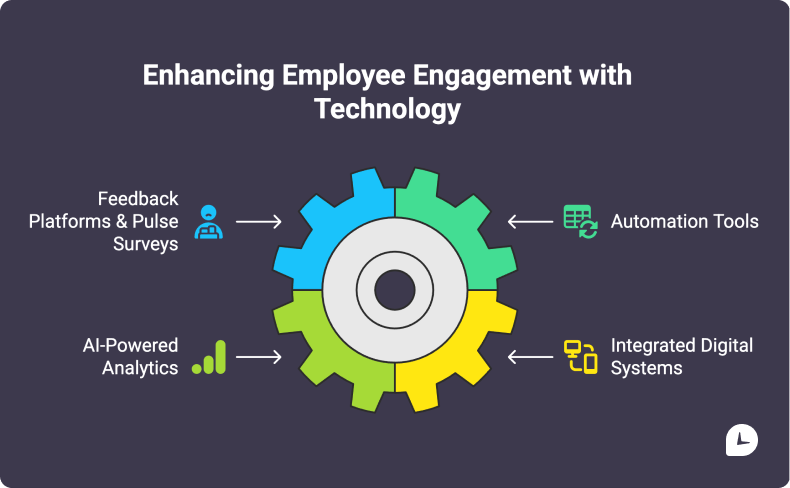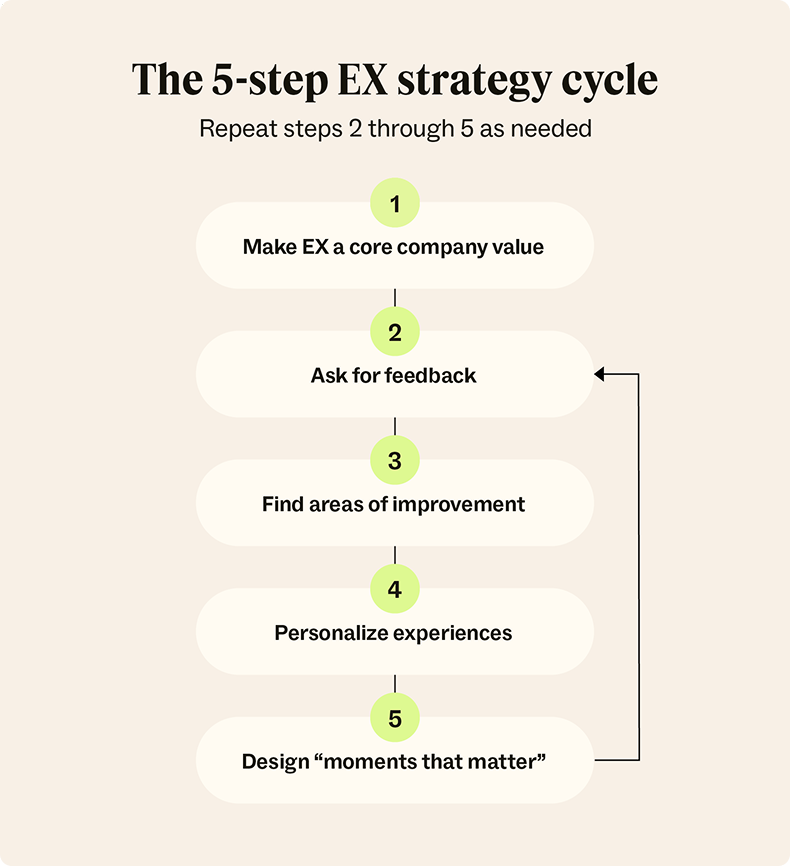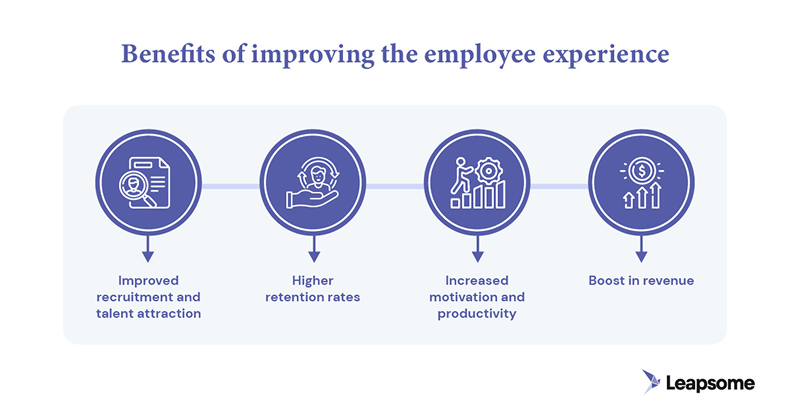What is Employee Experience Management? A Guide to Improving the Modern Workplace

Employee Experience (EX) is the full journey a person takes within your organization, starting from their first interaction as a candidate and continuing through to their final day — and sometimes beyond.
It covers every interaction: hiring, onboarding, daily work, tools, leadership, and growth opportunities. Done right, EX boosts happiness, performance, and employer reputation.
EX is often mixed up with employee engagement, but they’re different. Engagement is the emotional tie employees feel toward their work. EX is what creates that tie—through culture, systems, and environment. In short: EX builds the foundation; engagement is the result.
Why Employee Experience Matters Today
Work has changed. Hybrid schedules, digital workflows, and evolving employee expectations have pushed companies to rethink how they operate.
People want flexibility, a sense of purpose, and tools that actually work. They also want to feel heard, respected, and supported.
Organizations that respond to these needs — rather than ignore them — attract and retain top talent. They also outperform competitors in innovation, customer service, and profitability.
That’s why Employee Experience Management (EEM) has emerged as a strategic priority. It’s no longer about perks or surface-level changes. EEM is about creating a work environment that feels intentional and human-centered.
What Is Employee Experience Management
EEM is the ongoing process of designing, monitoring, and improving the experiences employees have throughout their time with a company. It includes collecting feedback, identifying trends, and making targeted improvements — not just reacting when people quit or complain.
At its core, EEM is about aligning organizational values with employee needs to build a workplace where people want to stay and do their best work.
This becomes especially important in times of change. Traditional management approaches — rigid policies, top-down communication, or generic benefits — often miss the mark in today’s dynamic, distributed workplaces.
A well-run EEM strategy keeps organizations agile and employees engaged.
How Technology Supports EEM
Technology is no longer just a support function; it’s now central to the employee experience. Digital tools shape how people collaborate, learn, and connect. The right systems allow companies to stay in tune with how employees feel and where friction exists.
For example, modern feedback platforms and pulse surveys make it easier to gather real-time insights. Automation tools cut down on repetitive tasks, giving people more time for meaningful work.
AI can even help identify turnover risks before they become a problem. And when HR systems, communication platforms, and learning tools are integrated, the result is a smoother, more consistent experience across the board.
Key tools include:

What Makes a Great Employee Experience
A strong EX isn’t about free snacks or cool office décor. It’s about how a company makes people feel on a daily basis — whether they’re supported, challenged, and respected. While the specifics vary by organization, some elements consistently shape the experience:
When these elements come together, employees don’t just stay — they thrive.
Understanding the Employee Journey
It starts with recruitment and onboarding. The hiring process sets the tone. Clear communication, respectful treatment, and a smooth transition into the role help new hires feel confident and welcomed.
Once settled, people look for opportunities to grow. Development, upskilling, and stretch assignments show that the company is invested in their future — and that their work matters.
As employees become more embedded, ongoing engagement becomes crucial. This is where recognition, inclusive culture, and consistent communication make a difference. Employees who feel seen and heard are more likely to stay involved.
Eventually, employees will either move up, move over, or move on. Retention efforts should focus on supporting career progression and keeping conversations open about goals and satisfaction. And when someone leaves, the experience shouldn’t end with a resignation letter. Thoughtful offboarding, exit interviews, and alumni networks help preserve the relationship — and the company’s reputation.
Every stage offers a chance to reinforce a positive employee experience. Neglecting any one of them can have long-term consequences.

The Business Case for EX
Investing in EX isn’t just about making people feel good — it’s about driving results.
Engaged employees perform better, collaborate more effectively, and are more resilient under pressure. A well-managed experience reduces turnover, saving time and money on hiring and training. It also minimizes burnout, which has become one of the most serious threats to productivity and morale.
There’s also a direct link between EX and customer satisfaction. Happy, supported employees are more likely to deliver better service, represent the brand positively, and build stronger client relationships.
When you invest in your people, they invest back!
Maximize productivity of your business
Track employee productivity and simplify work with them
How to Measure and Improve EX
To improve the employee experience, you need to measure it — regularly and thoughtfully:
1. Surveys & Feedback
- Example KPIs:
- eNPS Score (-100 to +100): “Would you recommend us as a workplace?”
- Engagement Rate: % who agree “I have what I need to do my best work”
2. Retention & Turnover
- Example KPIs:
- Voluntary Turnover Rate (aim for <10% in most industries)
- Top Performer Retention (e.g., 90% of high-potentials staying 2+ years)
3. Productivity Signals
- Example KPIs:
- Project Completion Rates (sudden drops may indicate EX issues)
- Absenteeism Rate (>4% may signal burnout)
4. Career Growth
- Example KPIs:
- Internal Promotion Rate (healthy orgs promote 15-20% annually)
- Training Participation (aim for 80% completing development programs)
Start with pulse surveys (3-5 questions monthly) and track just 2 KPIs (e.g., eNPS + turnover). Expand as you improve.
Common Challenges in EX Management
Managing EX isn’t always straightforward. Leaders may be skeptical or unsure how to measure ROI. Teams may have inconsistent experiences depending on their manager or location. Feedback might be collected, but not acted on. And some of the most important parts of EX — like trust, belonging, or fulfillment — can be hard to define, let alone quantify.
Still, none of these are reasons to avoid the work. Start where you are. Identify pain points. Focus on one or two areas you can improve, and build from there. Consistency and intention matter more than perfection.

Conclusion
Employee Experience Management isn’t about perks or trend-chasing. It’s about creating a thoughtful, supportive environment where people can do their best work and feel good doing it.
When organizations treat employees like people — not resources — they get loyalty, energy, and innovation in return.
A great employee experience isn’t accidental. It’s a choice — and one that pays off!
– The Monitask Team
Frequently Asked Questions
How do I measure Employee Experience?
EX can be measured through surveys, feedback tools, performance metrics, retention rates, and one-on-one meetings to gather both quantitative and qualitative data.
Why is Employee Experience important for business success?
A strong EX leads to higher employee engagement, reduced turnover, increased productivity, better customer service, and ultimately, greater profitability.
What are the key pillars of Employee Experience?
The key pillars include cultural alignment, physical & digital workspace, career growth, work-life balance, leadership, recognition, and the right tools & technology.
What challenges might I face in managing Employee Experience?
Common challenges include lack of leadership support, inconsistent experiences across teams, difficulties in acting on feedback, and measuring intangible factors like trust and engagement.



